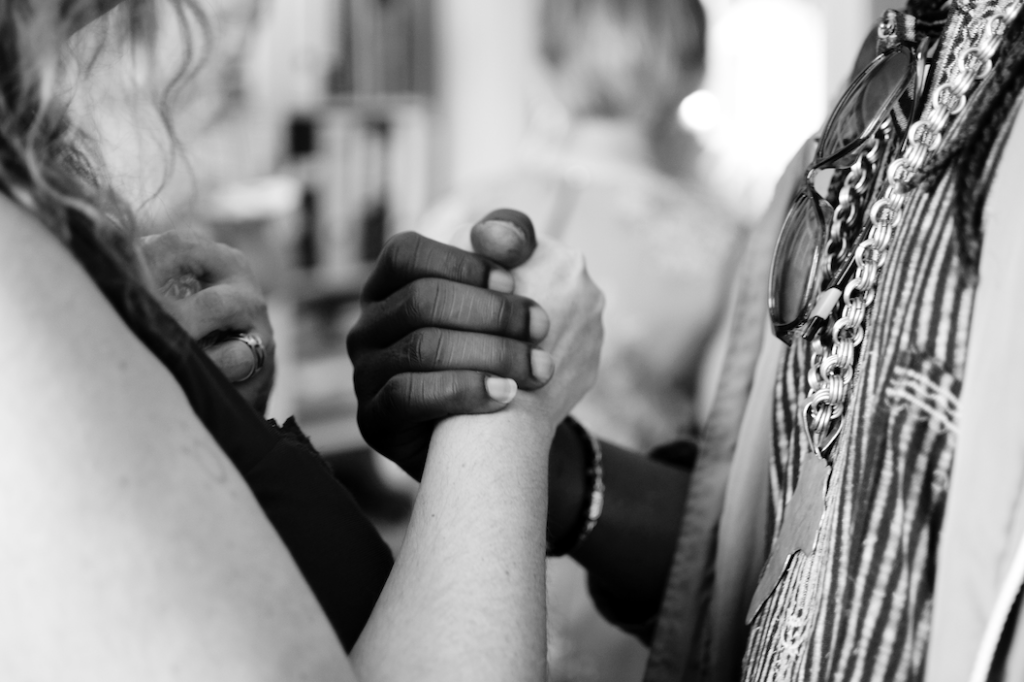
I was sitting around a friend’s house after being cooped up by a New England blizzard. I was getting that antsy feeling from being in one place too long. I needed to move. I needed to get outside. All I really wanted to do was go workout.
My friend, on the other hand, seemed perfectly content chilling on the couch. While I was mulling and pacing about, he was calmly resting, legs kicked up, fully reclined. I asked him,
“Don’t you ever get tired of resting at home?”
He paused and looked at me with a sly smile. Don’t you ever get tired of working out?”
Touché!
He said I simply haven’t learned to love the pleasures of rest days at home. In the same vein, I told him that he hasn’t learned to love the pleasure of moving around.
This is what Learning to Also Love the Opposite (LALO) is all about: leaning into the opposite of our attachments from a place of love and curiosity.
Learning to also love the opposite is one of the most powerful practices you can imagine. It will:
- Teach you equanimity by opening to experience the opposite of what you’re used to doing.
- Give you the freedom to choose how to respond to life because you are always challenging narrow preferences and dogmatic assumptions.
- Help you realize that because you like one thing, it doesn’t necessarily mean you dislike it’s opposite.
- Take the inherent duality of our world and our attachment to those divisions and reintegrate them.
Here’s how to put LALO into practice.
Level 1: Activity Preferences
Let’s start with some easy fitness examples.
- If you love distance running, learn to also love sprinting.
- If you love really heavy and fast workouts, learn to also love slow movements and stretching.
- If you love exercising with friends, learn to also love exercising on your own.
When I say “learn to also love”, I mean give it on for a try. Don’t foreclose on the experience just because you may have some initial opposition. Be willing to explore what it is really like for you. Start with these low-level activities that don’t have significant costs to you. When you feel ready for some challenge, progress to level 2. But first, a note on loving and liking.
Liking vs Loving
With the attitude that “I’m learning to also love something new,” you may begin to experience a shift in orientation. You may develop a tolerance for doing things that you did not like initially. You may also see how doing the opposite supports a greater good–developing a relationship with what you avoid or dislike.
It is possible you may become a convert and actually like doing the things you didn’t at first. However, liking the opposite isn’t the goal. The difference is important. Even if you never end up
Liking is about being fond of or attached to. Liking is conditional and fickle; it comes and goes. Loving is an absolute recognition of
Level 2: Habits
Here are a few examples of more interesting applications.
- If you have the habit of spending lots of money on possessions, learn to also love being frugal.
- If you have the
habit eating the same meal every day, learn to also love trying new foods and dishes. - If you have the habit of spending your leisure time with a few old pals, learn to also love meeting new people.
- If you have the habit of talking a lot, learn to also love listening.
You can see how LALO is an invitation to break out of your patterns. It is uncomfortable at first because the opposite is unfamiliar. Lean into it as an experiment to test your assumptions. This opens the possibility for a level 3 challenge.
Level 3: Personal Identity
When you practice LALO not just to external activities or daily habits but to how you operate in the world, it can be transformative:
- If you love thinking you have all the right answers, learn to also love being totally wrong.
- If you love being in control all the time, learn to also love being spontaneous and wild.
- If you love being praised for your work, learn to also love being ignored and overlooked.
- If you love being a caretaker, a peacemaker, an enthusiast, a challenger, an overachiever, a loyalist, a (fill in the blank personality trait), also learn to love being its opposite.
This is the hardest pill for most of us to swallow. This radical application of LALO cuts right into the heart of our identity by asking us to embrace what we think we are not.
I can hear people reading this and thinking to themselves:
Jeff, I’m an extroverted person. I thrive when I’m around others. How can I learn to become someone who enjoys solitude. That sounds so boring.
Jeff, I’m a creative individual who never follows the crowd. I’m all about putting my personal mark on things. How am I supposed to love fitting in with the
Jeff, I’m a progressive, liberal, earth loving vegan. How am I supposed to love a conservative, republican, meat-eating, industrialists? Just thinking about it makes me want to vomit.
Don’t worry, I’m not asking you to give up your identity. I’m suggesting you examine what parts of your personality you’re attached to. If this is giving you a visceral reaction, you are noticing the prison of your identifications. You believe that because you are one thing, you cannot also accept these other things, especially when they are the opposite of what you like and value.
The truth is you can be all these things.
You are capable of the opposite of everything you believe. Until you recognize this, own it, and embrace it, you will never be free. You will have placed a limit on your happiness by making it contingent on
Level 4: Identities You Don’t Choose
We are all born into bodies and histories that we did not choose. I will always be a white upper-class American. I will never be able to physically embody life as a Latino or someone born into poverty. These ethnic, class, body, and nationality inheritances raise an interesting question in the LALO framework:
- Do I even love these identity markers that I cannot change?
- If I am uncomfortable naming my own identity locations, how can learn to also love another?
- Can I embrace all the identities that I can never be and love them as if they were me?
Recognizing the identities we hold and the ways we hold them is the first step beyond assuming our experience is common and universally shared. Taking a LALO approach can help explore the narratives of those with different identities from ourselves without the usual ignorance, aversion, and fear of the unknown. [To learn more about Intersectionalities, Read: Do You Know Your True Face? – Lion’s Roar] L
Notes to Remember When Practicing Learning to Also Love the Opposite
“Both and And”
The key here is the “also” in the framework. I’m not suggesting giving up the things you like. Not am I suggesting abandoning your preferences. That would be equally as foolish and put you right back into dichotomous thinking. If your intent is to become free, you need to integrate your likes and your dislikes, not swap one for the other.
Not A Compromise
Learning to love isn’t about making a compromise. Compromises are usually not inclusive. They typically end up as a begrudging tit-for-tat. I’ll deny myself of something I want if you appease me in some other way. One person is usually somewhat unhappy.
Instead of compromising, focus on trying to include and integrate. If you feel like you are making a sacrificing, notice what parts of yourself feel scared or jeopardized. There will always be some fear, some trepidation, and perhaps some hurt you will need to work with. It may just be parts of your identity resisting letting go of control. It may also be the natural tension of holding contradictions together inside. It may be the realization that you were carrying around a lot more baggage than you thought. Often it is all of the above, so if you find something particularly sensitive or triggering, I’d suggest working with appropriate supports like a therapist, coach, or loving friend.
A Process, Not a Proscribed Outcome. Start Small.
LALO is a process for engaging with all that think you don’t like, feel you don’t want, and believe you are not. You will always be learning and loving. It may turn out that the learning piece is more significant for you because loving all these qualities is a far stretch at the moment. That is ok. I set the bar high. Begin with learning to just be with the opposite.
- Can you create space for it?
- Can you allow yourself to feel whatever you are feeling?
- Can you learn something from embracing rather than rejecting the things you push away?
Start small and then slowly work on bringing in loving intent.
Learning to Also Love is Not Chasing After
For non-emotionally charged behaviors
However, when it comes to intense emotional qualities, LALO can be misconstrued as acting from the opposite. For example, you may wonder if you love being happy, calm, and relaxed whether you should love being angry, upset, and stressed.
The goal isn’t to make yourself angry and then love it. It is to practice bringing love when these feelings naturally arise. If you can develop a loving relationship with all your emotions, then you can receive the wisdom and information they’re providing you.
Are You Ready to Set Yourself Free?
There is nothing more healing than using love as the glue that joins together these opposing sides of life—the light and shadow, the busy and the still, the smooth and rough, the black and the white, the loud and quiet, the mundane and the awe-inspiring.
As you learn to also love the opposite as a natural part of life, you may notice your aversion lessen. You may notice that won’t need to run from strong emotions and uncomfortable situations because you have honed your ability to handle both. When loving embrace becomes your default position in life, you’ll see opposites as opportunities to become more whole.
If you want more guidance on how to bring this into your own life, message me and let’s discuss how you can get started.
With love,
~ Jeffrey, and everything that Jeffrey is and is not.
I’m Jeff Siegel, a wellness coach and mindfulness teacher, helping people upgrade their habits and improve their health. For free bi-monthly wisdom on how to eat, move, and be healthier, sign-up for my newsletter. If you’d like to explore working together, you can schedule a private 30-min consultation call with me.


